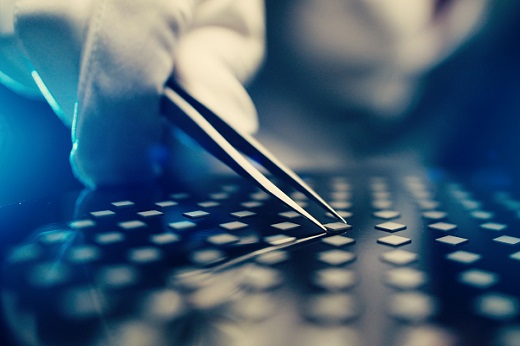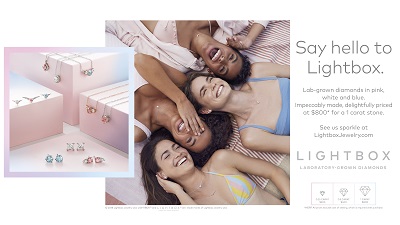|
|
How De Beers Sees Its New Synthetics Business
CEO Bruce Cleaver on why the company’s lab-grown diamonds won’t get a color or clarity grade, and why customers would tolerate losing them in the sea.
May 30, 2018 3:34 AM
By Joshua Freedman
|
|
|

RAPAPORT... De Beers is launching a jewelry line featuring laboratory-grown
diamonds — a venture that, according to CEO Bruce Cleaver, could eventually bring in
revenue of up to $200 million per year.
That figure might be small compared with the miner’s $6
billion natural-diamond business, but Cleaver and his team are entering the
synthetics retail sector because they see an opportunity to make a profit.
The new company De Beers is establishing, Lightbox Jewelry,
will sell fashion jewelry containing lab-grown stones at affordable prices —
$200 for a 0.25-carat stone, $800 for a carat. This reflects feedback from
consumers, who like the idea of synthetic diamonds as a fun piece for casual
occasions, but don’t think they’re worth the amounts they’d spend on a natural
stone for an engagement ring or to mark the birth of a child or a major
anniversary.
“They see diamonds as meaningful, in a way that lab-grown
diamonds aren’t — emotionally, financially,” Cleaver said. “For them, the issue
with lab-grown diamonds is they’re too expensive for what [consumers] think they are,
but they’re getting confused by the current offering, which seems to sort of
try to argue that they’re the same thing.”
In an interview with Rapaport News, Cleaver (pictured, below) explains what’s
behind the strategy, why the stones won’t get a color or clarity grade, and why
customers would tolerate losing these products in the sea. 
Rapaport News: What are consumers saying about lab-grown diamonds?
Bruce Cleaver: We’ve spent a lot of time in the last year and a half
analyzing consumers’ views on lab-grown diamonds, and what consumers really
want. What they tell us is the current lab-grown-diamond offering confuses
them. They don’t actually know if it’s the same thing as the natural type, or
something different. But when we ask them what they think it is, they say they
think it’s exactly what we’re pitching in Lightbox, which is something
completely different. For them, it’s a fashion product, an accessible product,
a fun product, a colorful product — one that doesn’t really compete with
natural diamonds because it’s a total different product, both from a pricing point
of view, and from the way it’s positioned and pitched.
That’s actually the opportunity we see, and that’s why we
want to launch this Lightbox business — to fill a space that no current
lab-grown producer fills, which is where we think consumers really want this.
And we don’t think that is contradictory with the natural business; we think
it’s complementary to it.
Rapaport News: What does that mean for the type of lab-grown diamonds
you intend to sell?
Cleaver: We’re going to have a lot more color — blue and pink — and a
lot less white than you would see in a natural offering, because that’s
consistent with what people want in fashion, fun and light-hearted jewelry. We’re
not going to grade them. Frankly, we don’t think they deserve grading, because
they’re all the same. You can tell your reactor to make whatever you want again
and again and again. They have no uniqueness and no rarity factor, so they don’t
deserve grading.
Rapaport News: You’re planning to sell 1 carat for $800. Does that
include the setting?
Cleaver: The setting, given that it’s a fashion product, is likely to
be silver, and is likely to be very inexpensive. Consumers tell us they don’t
think this lab-grown product belongs in the same space as a natural diamond. With
our technology [at Element Six, a De Beers subsidiary that has been making
synthetic diamonds for industrial purposes for decades], and with the cost that
we incur to produce these goods, we can make a profitable business positioning
lab-grown diamonds where we think consumers want them, which is in the hundreds
of dollars.

Rapaport News: How does pricing differ from that of natural diamonds?
Cleaver: Pricing of lab-grown diamonds, because it’s a fashion item
and there’s no uniqueness, is completely binary. If it takes you a week to make
a quarter of a carat and two weeks to make a half-carat, you’d expect the
half-carat to sell for twice [the price of] the quarter of a carat. That’s very
different to the natural business, where the pricing is different. It’s really
all in the offering and in being clear to consumers that this is a good
business for us, a fun business, but it’s a totally different business.
Consumers tell us things like, for example, these are the kinds of things you
can take on holiday and you can lose in the sea. You’d never do that with your
[natural] diamond.
De Beers remains, and always will be, a natural-diamond
business. We are spending about $3 billion on our current expansion programs
[in the natural-diamond space], and we’re certainly not stopping [our focus on]
those, we’re going more and more into those. That puts this offering into
perspective, where we’re going to spend $94-odd million building a new facility.
We’re serious about it, but it’s nothing like the scale of our natural
business.
Rapaport News: Is this a way into the diamond category for first-time buyers?
Cleaver: I don’t see this is as an entry into the natural space. I
see this as a totally different offering that some consumers want to
participate in. There’s no real emotional value in lab-grown diamonds, because they’re
not unique. They’re grown again and again in the same way, if that’s what you
want out of it.
Rapaport News: You plan to launch Lightbox Jewelry online in the US, and
announce retail partnerships in due course. Do you ultimately intend to sell
these products just online, or also in physical stores?
Cleaver: It’ll be both. We will launch an online offering first in
September, when we’ll start our first sales. We are in discussions with a
couple of retailers about some trials in stores as well.
Rapaport News: When could that happen?
Cleaver: It’s going to depend on how these discussions go, so I can’t
give an exact date, but I hope there will be some news relatively soon after we
launch the pilot online.
Rapaport News: Are we right to assume that no Lightbox jewelry will
appear in the Forevermark or De Beers Diamond Jewellers brands?
Cleaver: Absolutely, it is a totally different business. I’ve been
careful to separate the management teams. The Lightbox team does not report to
the core marketing team that Stephen [Lussier, De Beers’ executive vice president for
marketing and CEO of Forevermark] and co. lead. Stephen and his team remain
very focused on our core, natural business. The Lightbox team is a totally
different team reporting in through a different structure. So I’ve been very
careful to make sure there is no confusion between these.
Rapaport News: To whom does Steve Coe, the general manager of Lightbox, report?
Cleaver: He reports in to Neil Ventura, the [De Beers] head of
strategy, who reports to me.
Rapaport News: Once Element Six has produced the rough lab-grown diamonds,
who will cut and polish them?
Cleaver: Element Six will produce them [using chemical vapor
deposition, a method of creating synthetic diamonds], and already produces them
at [its UK facility in] Ascot, and we’re investing in an expansion facility in
Oregon. That’s also an Element Six facility.
We’ve been trialing cutting and polishing with a couple of
people in India who are going to be our contractors to cut and polish.
Rapaport News: Could this cause any repercussions for or confusion about
De Beers’ image?
Cleaver: It’s very important that we separate these brands within De
Beers. We’ve got separate management teams, separate marketing, very different
marketing aimed at different people.
Lightbox, although it’s brought to you from De Beers, it’s
not got the De Beers brand or the De Beers logo. De Beers remains synonymous
with diamonds, so we will continue to drive De Beers as a natural-diamond
business, and I think there’s no reason to think it will have any impact on us,
as long as we continue to focus the different brands in the way they should be.
I’m not particularly concerned about that.
Rapaport News: Which synthetic-diamond producers do you see as your
competitors?
Cleaver: A lot of people have produced lab-grown diamonds and are
selling them in retail, but no one that I’m aware of has positioned them in the
way we are. I prefer not to think about competition; I prefer to think about
what’s the best way for De Beers to maximize the value of its Lightbox
business. For me and the team, it’s about how do we do this best, giving
consumers what they want, and in return having a profitable business.
I’ll stress again the size of the natural business relative
to the size of the lab-grown business for us: It’s a small part of our world.
I’m focused on trying to find small adjacencies that are profitable to add to
the core business.
Rapaport News: Can you give a rough figure for the annual revenue you
are expecting from this business?
Cleaver: The [new Element Six] facility in Oregon, when it’s up and running
in 2020 and onwards, will, roughly speaking, be able to produce about 500,000
carats of rough [per year]. Broadly speaking, you could say that equates to 250,000 carats
of polished. You could see that could be, all in, a business with a revenue of
$150 million to $200 million, which is not insignificant, but is nothing at all
like our $5 billion to $6 billion [natural-diamond] business.
Images: Matt Crabb/De Beers
|
|
|
|
|
|
|
|
|
|
Tags:
De Beers, Jewelry, Joshua Freedman, lab-grown diamonds, Lightbox, Lightbox Jewelry, Rapaport News, retail, Synthetic diamonds, Synthetics, US
|
|
|
|
|
|
Well Done De Beers and very clever
|
|
May 30, 2018 10:20AM
By Eric Mor
|
|
Well Done De Beers!! The traditional diamond market should applaud these developments..Instead of having a dozen well synthetic diamond producers write this new chapter and dictate what a synthetic diamond is,De Beers took the synthetic diamond gorilla in the room by the cojonas through a clever jujitsu move and is now writing the book...
|
|
|
|
|
|
|
|
|

|
|